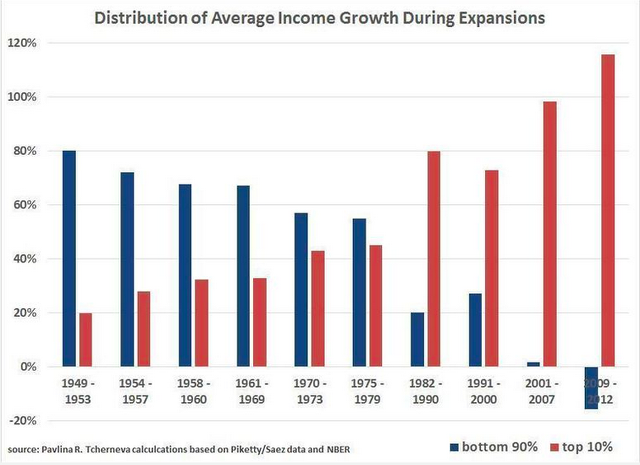Matthew Yglesias calls this chart, from Pavlina Tcherneva, an economist at the Levy Economic Institute at Bard College, “the most important chart about the American economy you’ll see this year.” It illustrates how much income gains those at the top have enjoyed during each of our post-war expansions.
Through the 1975-1979 expansion, more income gains went to the vast majority of the public than to the top 10 percent of households, but the opposite has been true since then. Inequality has grown with each subsequent expansion.
In the current recovery, at least through 2012, the bottom 90 percent actually lost ground, with all of the income gains being grabbed by the wealthiest 10 percent of American households. (Tcherneva relied on the oft-cited income shares database developed by economists Emmanuel Saez and Thomas Picketty.)
Tcherneva ran the numbers for the top one percent and the bottom 99 percent as well…

Average income growth in US recoveries: top 10% versus the bottom 90%. (Data: Pavlina Tcherneva; Graphic: New York Times)
In the paper which the top chart appears in, Tcherneva argues that policymakers have increasingly approached recessions by stabilizing corporations and the broader financial system, and argues that this approach has failed to “trickle down” to the majority of working people. “Conventional fiscal fine-tuning measures ensure that when government increases its total demand for goods and services, it first improves the conditions of the skilled, employable, highly educated, and relatively highly-paid wage and salary workers,” she writes. But “this trickle-down mechanism never quite trickles down far enough to create job opportunities for all individuals willing and able to work, irrespective of their skill and education level.”
One could make a broader structural argument as well: The shift Tcherneva identifies correlates with the end of the post-World War II period of “liberal consensus,” Ronald Reagan’s election and the rise of trickle-down economics. It also correlates with corporate America’s war on organized labor; workers saw a sharp decline in clout during this period. In 1979, the year before Reagan’s election, 21.2 percent of private sector workers belonged to a union; when he left office in 1989, that number had dropped to just 12.3 percent. By the time the 2009 expansion begins, private sector union membership had fallen to 7.2 percent. Policy-making doesn’t occur in a vacuum.
Tcherneva argues for more precisely targeted, bottom-up stimulus policies that would encourage full employment, instead of merely addressing gaps in consumer demand. (For more on that, see Dean Baker’s piece, “The Full Employment Route to Poverty Reduction.”)

This work is licensed under a Creative Commons Attribution-NoDerivatives 4.0 International License.



